
On 05.01.2022 in the Samarkand branch of Tashkent State University of Economics with the participation of professors - teachers and staff a lesson on foreign language courses "The Present Perfect tense" is conducted by English teacher G. Zahidova. Here we can consider: Present Perfect, that is, the present perfect tense - to show the connection between the past tense and the present tense, and to apply it to actions that took place in the past tense and the outcome of which is now known. In this case, to make sentences, we have or have after the possessive (I, you, we, he, she, it) and add -ed to the verb.

For example: I + have + work + ed I have worked. In the third person singular (he, she, it) we use has instead of have. He has worked. My mother has cleaned. We can abbreviate have to ‘ve’ and use has to ‘has’. He’s worked. I’ve done my homework. When we create a negative form, we put a note after have / has. I have not done my homework. My mother has not cleaned the room. We often use the abbreviated form. have not = haven’t; has not = hasn’t Verbs are 2 different. Right Verbs and Wrong Verbs We give an example of this: Regular verbs llarga -ed, suffixes are added.

For example: work - worked; play-played; Irregular verbs: These verbs do not follow the above rule. We do not add -ed to use these verbs in the past tense or perfect. They have their own past tense and adjective forms. We can use these. Maslaan: buy - bought At the end of the lesson - slide interrogative form have, has information about the types of construction with the help of auxiliary verbs from the owner. English teacher G. Zahidova made today's lesson in a foreign language meaningful and interesting.
